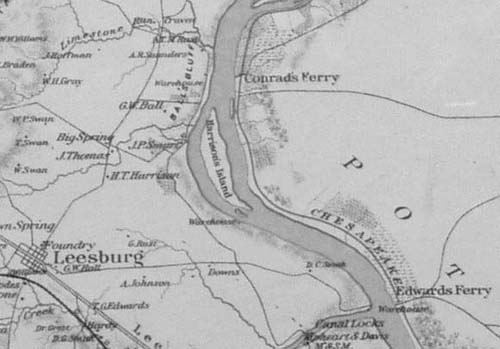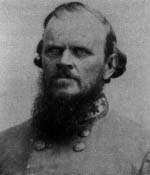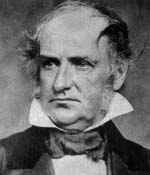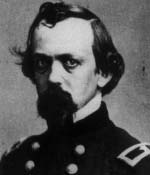
Map
detail from The Atlas to Accompany the Official
Records of
the Union and Confederate Armies-- (Plate VII)
Northeastern Virginia and Vicinity of Washington,
Bureau of Topographical Engineers, August 1, 1862
|
Chronology
of the Battle of Ball's Bluff
(based on U.S. Army Staff Ride Guide)
October
19, 1861:
-
Confederates
withdraw from the vicinity of Washington to take up defensive position
near Centreville, but 7th Brigade under Col. Nathan G. Evans remains
near Leesburg.
-
The
Union commander, General George McClellan sends a force from Langley,
Virginia up to Dranesville, hoping to force the 7th Brigade to withdraw
from the Leesburg area.
-
Union
signal station on Sugar Loaf Mountain informs McClellan that the
Confederates appear to have moved away from Leesburg.
-
McClellan
sends a message to General Charles P. Stone in Poolesville, suggesting
a "slight demonstration" by his division to encourage
the Confederates to withdraw.
-
Stone
sends the 42nd New York Infantry to Conrad's (now White's) Ferry,
and has General Willis Gorman advance to Edwards' Ferry send two
companies of the 1st Minnesota Infantry across the river. (By evening,
this party returns to the Maryland shore.)
-
A
Union scouting party crosses the river at Ball's Bluff around 1PM
and returns at 10PM, reporting that it saw an unguarded Confederate
camp about a mile from the river. Stone orders five companies of
the 15th Massachusetts Infantry to cross that night and attack the
Confederate camp at daylight, with two companies of the 20th Massachusetts
crossing to support them.
-
By
4AM the crossing is complete, and around 7AM, the Massachusetts
companies discover that the "camp" was actually a row
of trees sillhouetted along a ridge line.
-
Stone
orders another crossing at Edward's Ferry as a diversion.
-
Confederate
forces begin to skirmish with the Massachusetts Infantry near the
Jackson house, and additional Confederate and Union forces move
to the scene.
-
At
10AM, Colonel Edward D. Baker, also a U.S. Senator and personal
friend of Lincoln's, arrives at Stone's headquarters and is given
command of all troops in the vicinity of Harrison's Island. Baker
orders additional units to cross the river and proceeds to Harrison's
Island around noon to assist.
- By
2PM, Colonel Baker crosses over to Ball's Bluff to take command. His
attempt at an advance is repulsed.
- Around
5PM, Colonel Baker is killed and Colonel Cogswell takes over. A Union
attempt to break through and escape towards Edward's Ferry fails.
Union forces are driven back to the bluff and Cogswell orders a general
retreat, crossing back to Harrison's Island. With only a narrow and
steep path back to the river, troops scramble and fall down the bluff
to get to the three boats that were ferrying the troops back and forth.
Union officers advise the men to throw their weapons in the river
and save themselves.
- By
6PM, the last remaining boat is swamped and many Union soldiers attempt
to swim over to Harrison's Island, under fire from the Confederate
forces. Colonel Cogswell and other Union officers are captured on
the Virginia shore.
-
Under
a flag of truce, a Union burial party crosses from Harrison's Island
to Ball's Bluff.
-
Union
General Lander is seriously wounded in skirmishing on the Virginia
shore opposite Edward's Ferry.
-
After
dark, General McClellan orders all Union troops on Harrison's Island
withdrawn to the Maryland shore.
There
are no authoritative casualty figures on the Union side; as many as
200 men may have been killed, with hundreds more captured by the Confederates.
Over the next two weeks, the bodies of 20 Union officers and men were
found downstream along the Potomac, one of them at Great Falls. The
Confederates lost a total of 36 men killed.
|
 Col.
Nathan G. Evans
Col.
Nathan G. Evans
Confederate States Army |
 Col.
Edward Baker
Col.
Edward Baker
United States Army |

Gen.
Charles P. Stone
United States Army
|
|
|
Photos
from U.S. Army Military History Institute.
Sources:
-
The War of the Rebellion: A Compilation of the Official Records
of the Union and Confederate Armies, Series 1, Volumes 5 and
51, Washington, DC, Government Printing Office, 1893
- Report
of the Joint Committee on the Conduct of the War, Washington,
DC, Government Printing Office, 1863
- History
of the Battle of Ball's Bluff, written by Col. E.V. White, Leesburg,
Virginia, reprinted in 1985 by the Manassas City Museum. [No date
given for the original printing.]
- Touched
with Fire: Civil War Letters and Diary of Oliver Wendell Holmes,
Jr., Edited by Mark DeWolfe Howe, Harvard University Press,
Cambridge MA, 1946. [Includes a letter to his mother and portion
of his journal describing the battle and his wounding.]
- Battle
of Ball's Bluff, Staff Ride Guide, Ted Ballard, Center of Military
History, U.S. Army, Washington DC, 2001 [74 pages, available from
Government Printing Office]
|




